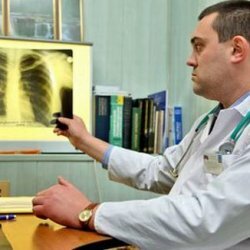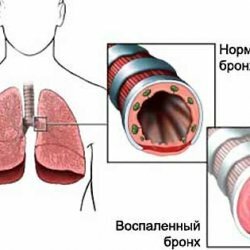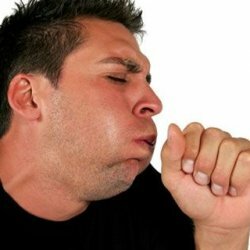Viral pneumonia - symptoms, treatment, prevention
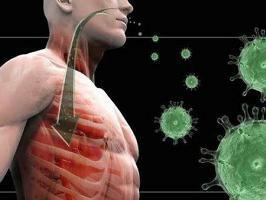 Pneumonia( pneumonia) is a rather dangerous disease, which, according to statistics, most often causes death in childhood.In medicine, there are three types of the considered disease - bacterial, fungal and viral.In this article, it will be specifically about viral pneumonia, which doctors consider as the most serious type of disease.
Pneumonia( pneumonia) is a rather dangerous disease, which, according to statistics, most often causes death in childhood.In medicine, there are three types of the considered disease - bacterial, fungal and viral.In this article, it will be specifically about viral pneumonia, which doctors consider as the most serious type of disease.
Causes of development of viral pneumonia
Viruses are the main cause of pneumonia development in childhood and in people over 65 years of age.This is due to the fact that their immunity is weak, the body is susceptible to any infection.For the same reason, viral pneumonia is dangerous for pregnant women, especially since the development of the disease under consideration can lead to miscarriage at early stages and to premature births at later stages.
In most cases, viral pneumonia proceeds in mild form, and its treatment lasts only three weeks, but this same disease can occur in severe form and lead to death.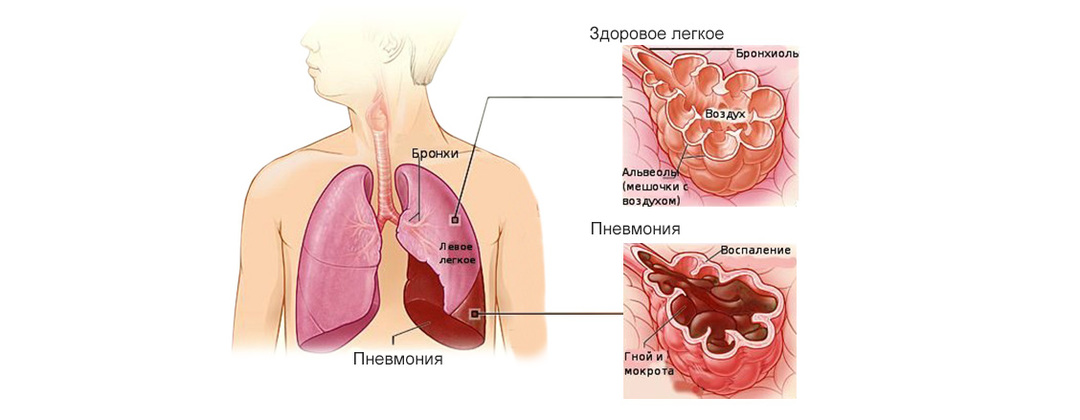
This disease can cause a number of viruses. These include:
- parainfluenza virus;
- cytomegalovirus;
- adenovirus;
- influenza A and B virus;
- herpes virus 1 and 3 types;
- measles virus.
It is still not clear how viruses begin their "activity" in the lungs, but it is obvious that after infection, the lungs begin to resist pathology, which provokes the development of the inflammatory process in the paired organ.The inflammatory process provokes a blockage of oxygen supply to the lungs - this causes pronounced symptoms of the disease.
Please note: viruses are transmitted from person to person by sneezing, coughing or touching the contact surface.
Viral pneumonia is a consequence of the flu
One of the main causes of the development of viral pneumonia is influenza type A and B. A particular danger is influenza A H1N1 - the so-called swine flu.The name got its disease not because people get infected from pigs, but because these fauna representatives are also sick with such a disease.
Symptoms of swine flu( type A H1 N1):
- sharp onset of the disease - since the morning the person feels fine, in the evening - goes to bed;
- increase in body temperature to critical values - 38, 5 and above degrees;
- is a headache of a harsh nature;
- heavy perception of any noise and movement, inadequate response to light;
- dry cough - "barking";
- sensation of lung compression - intense pain behind the sternum;
- strong weakness, aches all over the body.

Note: in the development of swine flu, against the background of severe intoxication, the patient may begin vomiting.But it is extremely rare that the flu A( H1 N1) is accompanied by a runny nose and conjunctivitis.
Viral pneumonia against the background of swine flu is a complication when viruses penetrate the respiratory tract and cause a rapidly progressive inflammatory process.It is the disease under consideration that is causing the death of patients, and not the flu, as most people think.
Symptoms of viral pneumonia against the background of swine flu:
- cough - in the first hours of the disease dry, then passes into paroxysmal and sputum;
- fever and chills in the background of high body temperature;
- pain in the head - strong, pressing, can have a paroxysmal character;
- general weakness - some patients do not have the strength to even get out of bed and reach the toilet.
Note: viral pneumonia against swine flu is always developing rapidly and if medical assistance is not provided on time, the patient's death may occur in the first few hours of the disease.
Treatment of viral pneumonia in the swine flu
Important: is the most important thing - do not self-medicate!When the first symptoms appear( fever and sudden weakness), immediately consult a doctor - it is advisable to call a specialist at home.
No antibiotics( antibacterial agents) to cope with the disease under consideration will not help - the doctor must choose specific antiviral drugs. The most commonly prescribed are:
- amantadine and / or remantadine - etiotropic antiviral agents;
- zanamivir;
- oseltamivir.
Note: treatment of viral pneumonia with folk remedies against the background of swine flu is impossible.Do not risk your own life and try to be treated with lime tea, raspberry, propolis, chamomile and other well-known products.As a result of this self-treatment, patients get to specialists already in serious condition, when it is appropriate to use only resuscitation measures.And this frivolity can end sadly - death from viral pneumonia against the background of swine flu can occur within a few hours after the onset of the disease.
To quickly distinguish acute respiratory disease from influenza, it is worthwhile to know the specific manifestations of symptoms.This will help you understand the table below:
| Symptoms | Colds | Influenza |
| temperature | Sometimes, usually not high | almost always high( 38-39S °, especially in young children), lasts 3-4 days |
| Headache | Sometimes | Often |
| Other pain | not strong | Often, strong |
| WeaknessSluggishness | Sometimes | often can last 2-3 weeks. |
| Heavy state, depletion | Never | often, especially early in the disease |
| Stuffy nose | Often Sometimes | |
| Sneezing | Often | Sometimes |
| Sore throat | Often Sometimes | |
| chest discomfort | From light to moderate | Often, there is a strong |
| Kass | Dry cough | |
| Complications | sinusitis, otitis media | Sinusitis, bronchitis, middle ear infection, pneumonia, MBlife-threatening |
| Prevention | Wash your hands often, avoid contact with sick colds | Wash your hands often, avoid contact with flu patients, Get vaccinated against seasonal flu, consult your doctor about antiviral drugs |
| Treatment | Antihistamines, anti-pediatric, anti-inflammatory drugs | Antihistamines, decongestants, analgesics( ibuprofen, paracetamol), antiviral in the first 48 hourss after the onset of symptoms.An effective remedy for both colds and flu is the preparation Antigrippin.Ask the doctor for more information. |
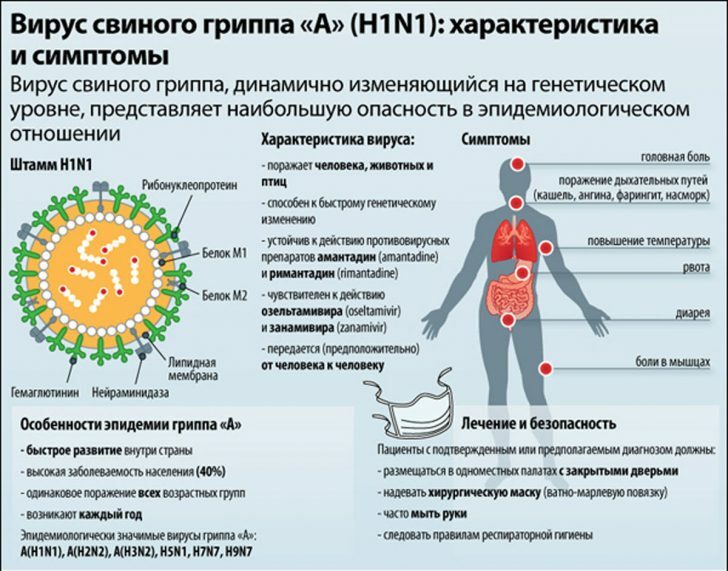
Viral pneumonia in the background of parainfluenza
Statistically, parainfluenza is the second most frequent cause of the development of the disease in question.It is noteworthy that the pneumonia of the viral etiology against parainfluenza has a very small incubation period - from 1 to 5 days, and in children up to 5 years it can be only 24 hours.
The greatest danger is parainfluenza type 3.Symptoms of it are pronounced, which allows for early diagnosis. The first signs of parainfluenza type 3 include:
- cough;
- runny nose;
- breathing "with a whistle";
- wheezing in the background of dyspnea.
And these all the symptoms manifest themselves against the background of high temperatures!And when there are signs of viral pneumonia, they are symptoms of a cold - in patients there is a strong rhinitis( runny nose) and conjunctivitis.
Cytomegalovirus pneumonia
Inflammation of the lungs can develop against a background of cytomegalovirus infection, but not in everyone.For this it is necessary that several factors "come together" - for example, a patient with diagnosed cytomegalovirus has AIDS or organ transplantation, chemotherapy.
Note: in most people cytomegalovirus infection is asymptomatic and without complications.But the risk of developing viral pneumonia remains very high, therefore, preventive measures should be taken to prevent such an outcome.
Treatment of cytomegalovirus pneumonia consists in the administration of specific antiviral drugs, but only under the supervision of a physician.
General principles of treatment of viral pneumonia
The purpose of therapy in the disease under consideration is to combat the symptoms of infection, enhance and strengthen immunity, and rid the body of the infection. Typically, doctors prescribe specific antiviral medicines:
- ribavirin;
- remantadine;
- Acyclovir( antiherpetic drug).The derivatives of this drug may also be effective - for example, foscarnet, ganciclovir and cidofovir.
It is mandatory to conduct the patient and symptomatic therapy in the diagnosis of viral pneumonia .Within this type of treatment it is recommended:
-
 Course of corticosteroid preparations.
Course of corticosteroid preparations. - Medicinal preparations for cough - are selected taking into account its nature and existing contraindications in the patient.
- Antipyretics - this may be acetylsalicylic acid, ibuprofen( non-steroidal anti-inflammatory drug), or acetaminophen.
- Full nutrition and quality rest( it is advisable to comply with strict bed rest) - this will help the body to accumulate strength and quickly cope with the infection.
- Abundant drink - this will help to thin the sputum and accelerate its release from the respiratory tract.
- Oxygen therapy - will prevent the development of cyanosis and help the body cope with a temporary oxygen starvation.
Please note: If in time to seek medical help, clearly follow all the recommendations and appointments of specialists, then viral pneumonia will be cured in 10-20 days( the exact time depends on the general health of the patient and the severity of the disease in question).If viral pneumonia was not diagnosed at once, the treatment was prescribed the wrong one, then development of cardiac and respiratory insufficiency is possible.
Preventative measures
Since viral pneumonia is most often a complication of infectious diseases, you should know how to prevent precisely the main pathology.
Prevention of influenza during the activation of the virus:
- avoid being in crowded places;
- after visiting the streets and various institutions, you should always wash your hands with soap and rinse the nasal passages with saline solution;
- does not stand on the street and in public places touching your face( lips / eyes / nose), stop gnawing pencils / pens, wipe gadgets periodically with disinfecting napkins - on all surfaces viruses can settle.
No immunomodulators and other medications in the prevention of influenza can be taken independently - they should be prescribed by a doctor.
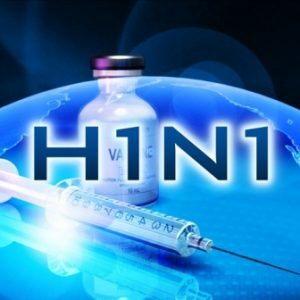 Note: is the most reliable way to prevent infection with the influenza virus, which entails the development of viral pneumonia, is considered vaccination.But it should be done before the mass infection begins.
Note: is the most reliable way to prevent infection with the influenza virus, which entails the development of viral pneumonia, is considered vaccination.But it should be done before the mass infection begins.
Many believe that a medical mask will save a virus from a flu virus - this is only partly true, because the viruses are so small that they can penetrate even through the pores.Doctors recommend wearing a medical mask while in institutions, but on the street it is better to remove it - the chance to catch flu in the fresh air is minimal.
In all other cases, the prevention of the development of viral pneumonia will be compliance with the elementary rules:
- timely treatment of all infectious and inflammatory processes in the body;
- periodic reception of immunomodulators and vitamin complexes;
- regular visit to the doctor and preventive examination;
- promptly seek medical attention when the first symptoms appear.
Viral pneumonia is an insidious disease that begins too gently and with unintentional symptoms, but after a few hours is a threat to the life of the patient.Only a timely appeal to doctors, the implementation of all prescriptions and recommendations will help to treat the disease in question without any complications.
Tsygankova Yana Alexandrovna, medical reviewer, therapeutist of the highest qualification category.

